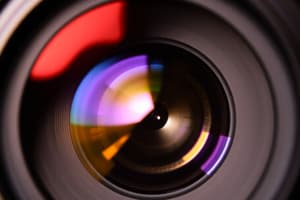Podcast
Questions and Answers
Why does the lens have a smaller focusing power compared to the cornea?
Why does the lens have a smaller focusing power compared to the cornea?
- The lens has a more complex layered structure compared to the cornea.
- The lens lacks the ability to change shape, unlike the cornea.
- The lens is surrounded by substances with refractive indices similar to its own. (correct)
- The lens is located further away from the focal point than the cornea.
How does the shape of the lens contribute to its function?
How does the shape of the lens contribute to its function?
- Its variable shape enables focusing on objects at varying distances. (correct)
- Its rigid shape maintains a fixed focal point, ideal for distant objects.
- Its consistent curvature ensures uniform light refraction for all distances.
- Its flat shape minimizes distortion, providing a clear image.
What is the correct order in which light passes through these structures of the eye?
What is the correct order in which light passes through these structures of the eye?
- Aqueous humor → Cornea → Lens → Vitreous humor → Retina
- Lens → Cornea → Aqueous humor → Vitreous humor → Retina
- Cornea → Aqueous humor → Lens → Vitreous humor → Retina (correct)
- Cornea → Lens → Aqueous humor → Vitreous humor → Retina
Considering the structural composition of the lens, how might the varying refractive indices of its layers affect its function?
Considering the structural composition of the lens, how might the varying refractive indices of its layers affect its function?
If the refractive index of the substances surrounding the lens were significantly higher, how would it impact vision?
If the refractive index of the substances surrounding the lens were significantly higher, how would it impact vision?
Flashcards
What is the lens?
What is the lens?
The structure in the eye that can change shape to focus on objects at different distances.
Lens focusing power
Lens focusing power
The lens's focusing ability is less powerful than the cornea's due to similar refractive indices of surrounding substances.
Lens Composition
Lens Composition
The lens is composed of multiple layers, similar to an onion, with varying refractive indices.
Vitreous Humor
Vitreous Humor
Signup and view all the flashcards
Sclera
Sclera
Signup and view all the flashcards
Study Notes
- The eye's lens focuses objects at various distances due to its variable shape.
- The lens's back surface is more curved than its front.
- The lens's focusing power is about 1/3 of the cornea's.
- This is because the lens is surrounded by substances with refractive indexes close to its own.
- The lens consists of layers, similar to an onion, and each layer has a different refractive index (n).
- Key parts of the eye include the retina, sclera, cornea, aqueous humor, lens, and vitreous humor.
- The lens also contains the epithelium, equatorial region, and nucleus.
Studying That Suits You
Use AI to generate personalized quizzes and flashcards to suit your learning preferences.




